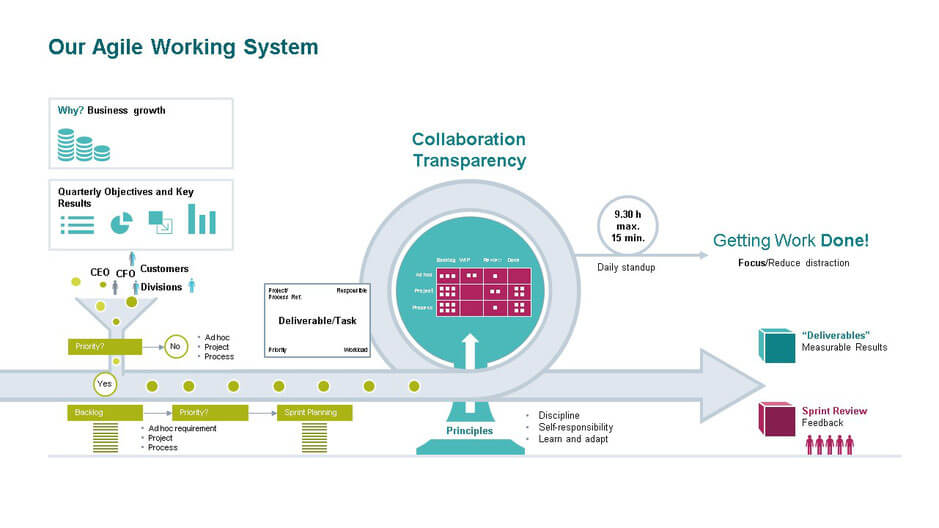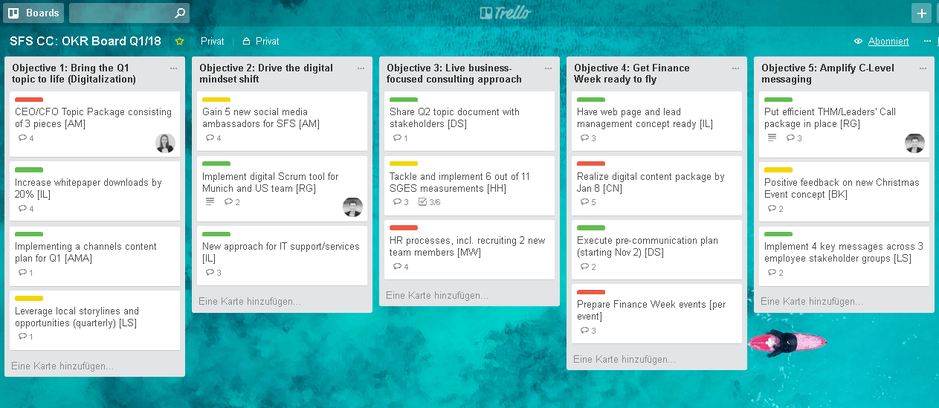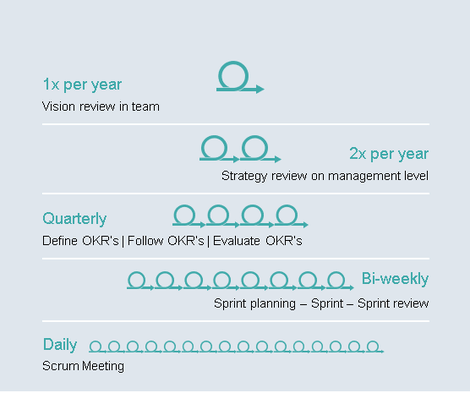Another eventful year has just begun – bringing with it a renewed aspiration to master the dynamics and complexities of the digital age. Personally, I see the challenges around more than innovating new business models, applying future technologies and exploiting the opportunities of digital communications. It also has a lot to do with creating a clear strategic direction and changing the way we work – so that it reflects market dynamics, engages the team, enables digital transformation and, ultimately, drives culture change.
In the past year, we have dedicated a great amount of focus to identifying ways to transform our communications team at Siemens Financial Services in the digital age. During that time, all 13 of our team members – in Germany as well as the UK and US – brought our agile working system to life and developed it further in several iterations. In retrospect, this wasn’t exactly a given, as several colleagues in our own company as well as in the agile community said:
“This will never work at Siemens – such a large company with complex matrix structures, a long tradition in process definition and hierarchies.”
I’d like to share with you both the way we made it happen it in practical terms and the kind of conclusions that we can draw now looking back at our progress. My hope is that these points can spark some discussion on how to overcome the challenges of digitalization in dynamic settings, and I look forward to reading and responding to your comments and any additional inspirations you’d like to share for the year ahead.
#1 Be clear on your WHY
Back in April, we were in a situation faced by many other teams these days. Communicating in VUCA (Volatility, Uncertainty, Complexity, Ambiguity) times had created tensions: How do we deal with an ever-increasing workload? When new tasks come in, how can we reduce time-consuming processes that do not regularly create results? Are tasks split in a fair way across the team, and how can we prioritize faster, if necessary? How can we speed up our own decision-making to communicate at the pace of our digital channels? How can we create more digital content that sparks conversations with customers? How, in this complex environment, can we continue to prove that we generate value for our company? We decided to take two days off to discuss and analyze the situation, together with Stefan Hagen [https://hgn.io/] who provided us with an agile kickstart and with valuable feedback and input during our journey. Our time with him yielded two significant results:
- We developed a vision for our team, clarifying why communications plays a key role for Siemens Financial Services and how we as communicators can fulfill this role: “Our vision is to drive business growth by means of communications.”
- We concluded that we need to start with a new way of working immediately – in fact, before we are ready to do so. This was driven by the recognition that we would not be able to overcome our specific challenges by copying existing models.

#2: Create transparency, grounded in an agile working system
Back in the office, we started to fine-tune our new way working. Yes, we had heard of IT teams and startups that swore by the Agile Manifesto and Scrum Guide. But as a communications team of a major conglomerate, we weren’t sure they would be the right fit for us: We don’t focus on one single product, and we would need to master a multitude of tasks within a specific sprint. In addition to actual project work, we need to deal with a range of processes – procurement, budgeting and HR, to name a few – that keep us busy and tend to distract from product focus. Also, we regularly receive stakeholder requests, mainly from C-Level and senior management, requiring us to change specific deliverables on short notice.
“Just do it!”, was the motto we followed.
Still feeling overwhelmed by the amount of work awaiting us, we started to depict all existing tasks in the backlog section of a whiteboard. Working with Post-it notes helped us to act and visualize immediately. In a second step, we color-coded the tasks by three types: projects, processes and ad hoc tasks. After six to eight weeks, we managed to reduce the proportion of process tasks from over 40 to less than 20 percent. Following the scrum framework, we established daily standup meetings. The 15 minutes that the team invested in these meetings helped us to cut back on individual jour-fixe meetings with team members as well as many individual questions that used to crop up during each day. We established biweekly review meetings, lifting team collaboration to a new level and initiating an ongoing improvement process.
In order to involve colleagues in other locations in the UK and US, we subsequently transferred our manual whiteboard to Trello boards – a flexible online solution that allowed us to tailor digital boards to our needs and work jointly from different locations.
The role of Scrum Master also required some adjustment from our original framework. We take turns filling this role within the team so that every team member has the opportunity to take ownership of sprint execution.

#3 OKR and servant leadership
For me, as team leader, agile transformation meant consciously stepping back from my former role as innovation driver, “approver” and link to senior management. Discussions within our team revealed that the new way of working requires a team coach who fosters collaboration, communicates stakeholder expectations and makes the occasional quick decision when the team cannot agree on a solution.

This need to redefine the role of team leader became apparent just a few months into using the new system. We had managed to gain full transparency of tasks and also shifted time previously spent on processes to more project work. The open question, then, was how to actually prioritize projects in a way that supports our communications strategy and the long-term team mission and vision. We decided to implement quarterly objectives and key results (OKR). The objectives are four or five qualitative goals that describe how the team wants to contribute to mission achievement in a specific quarter. In turn, key results define four or five quantified deliverables to achieve these goals. Rather than defining OKRs top down, we started with a 100% bottom-up process, brainstorming and negotiating the first quarterly system entirely as a team – an exercise of intense discussion and prioritization that took place over nine hours, leading to flexible sub-teams working on each key result. We even managed to slice a large, group-wide project such as Siemens Finance Week into quarterly key results.
For future quarters, we will apply the OKR system to intensify stakeholder relations by involving Division and Business Units CEOs and CFOs in prioritizing activities and use OKRs as starting point to expand our stakeholder consulting process. At the same time, by combining the OKR framework with our daily standup meetings, we’ve created a framework that helps team members to self-organize and decide on execution on their own, rather than waiting for approvals. This ability to act quickly is crucial in times of digital communications.

#4 Learn to love loops

One key thing we learned from implementing our agile working system was that we cannot simply copy and paste existing tools into our environment and expect this alone to make the difference. The difference comes from digging deep into our own situation, analyzing the WHAT and HOW of our very specific work and practices – and from applying an agile mindset to these.
We probably were not fully aware of this when we started, but we found that we need a working system that connects long-term vision to our daily work – one that allows us to break the team vision down into short cycles of autonomous action within the team. This can be anything from issuing a social media post or moderating a workshop to finishing a specific animation that forms part of a larger campaign. This way of thinking in loops can also connect annual planning and budgeting with biannual strategy reviews at the management level. Quarterly OKRs increase flexibility in strategy execution and allow communications to adapt to changes in markets, customers and company priorities. Daily standup meetings paired with biweekly sprint reviews allow for immediate adjustment and support, and the more holistic view that team members gain of each other’s work from this setup has the added bonus of significantly increasing the quality of internal collaboration.
#5 Grow the story by sharing experiences
When we started our agile working system back in April 2017, we were fully aware that this was an experiment – a humble start with an open end. Yet, as written down in our vision, we want to drive the digital mindset of Siemens. So, we made it a habit to share our story of a team in agile transformation. By doing so, we were able to make new connections and build new networks to neighboring departments such as HR and IT as well as other divisional and regional communications teams that were also dealing with challenges of digitalization and trying to address them in their own agile ways.
In telling these stories, we focus on the following concrete results we’ve achieved with our new way of working:
- Approaching upcoming tasks with full transparency helps our small team feel ready and prepared to make large projects a success.
- We have clearly increased our customer and stakeholder focus. A more proactive consulting mode, based on joint objectives, allows for short-term adjustments. Including stakeholders in our agile routines puts us in a position to continuously reflect and address business needs.
- We have become more efficient in WHAT we do. This can be measured in the continuous reduction of process activities (the things that keep us busy without producing concrete key results) vs. a clear increase in value-creating project deliverables.
- We are faster and more flexible in our execution, which is a basic requirement and ongoing challenge in digital communications.
- Team spirit is rising: The challenge of feeling overwhelmed is minimized by breaking tasks down into manageable work packages for each day. The new level of transparency that we achieved by having all projects and tasks visible in front of us at any point in time, increased the feeling of fairness. Clarifying tasks helps to identify opportunities for collaboration – although making it happen requires a longer-term approach.
In summary, our agile team transformation will continue throughout 2018. We are fully aware of the fact that we need to train our agile muscle every day in dealing with upcoming challenges: How can we foster even more collaboration between team members? What are the right agile tools and practices to further increase ownership in the team? Even if we are working in an agile team now – other units around us are probably not. What is the right approach to further spread the ideas of agile working in the community of communicators and beyond? With stakeholder expectations changing and new situations coming, we also need to continuously adapt our own working system. Finally, we need to discipline ourselves to stay on track and keep going on our agile journey.
The article was also published on LinkedIn:
https://www.linkedin.com/pulse/clear-your-direction-focus-agile-collaboration-start-before-huebner/



